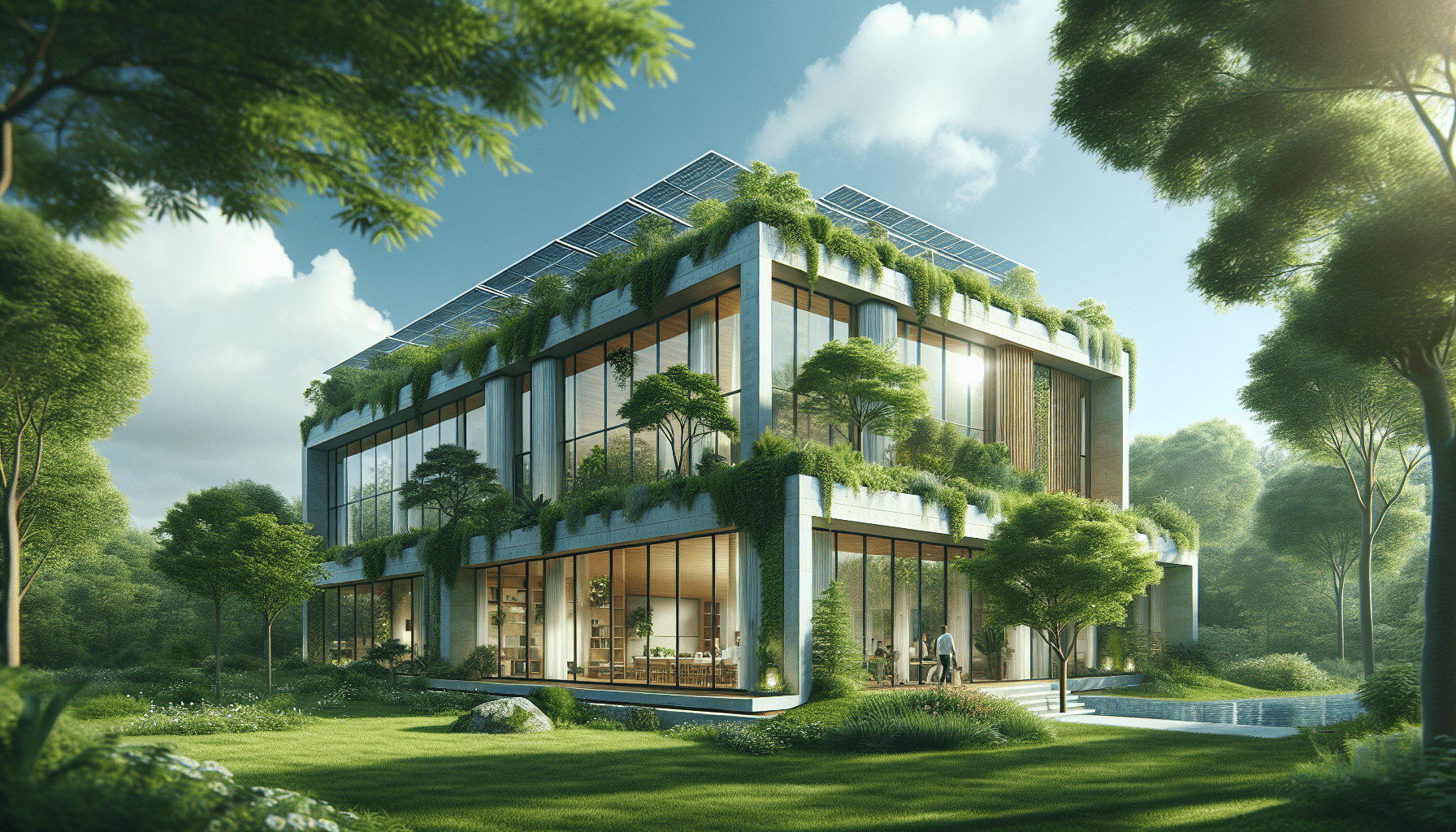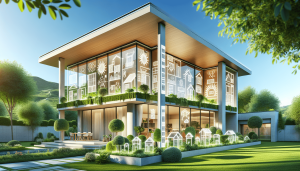In our quest to create a harmonious living environment, sustainable architecture has emerged as a front-runner in enhancing occupant comfort. By integrating eco-friendly materials, energy-efficient systems, and thoughtful design, we not only minimize our environmental footprint but also cultivate spaces that promote overall well-being. Sustainable buildings often include features such as increased natural light, improved indoor air quality, and temperature regulation, contributing to a more comfortable and healthful experience for occupants. As we delve deeper into the article “How Does Sustainable Architecture Enhance Occupant Comfort?”, we’ll uncover the myriad ways in which these innovative practices can transform our living and working spaces for the better. Have you ever wondered how sustainable architecture can enhance the comfort of building occupants? It’s a fascinating topic that combines cutting-edge design with eco-friendliness to create spaces that are not only better for the planet but also for us. Let’s dive in and explore how thoughtful architectural practices can make our indoor environments more comfortable, healthier, and more enjoyable.
What is Sustainable Architecture?
Sustainable architecture aims to minimize environmental impact by using energy-efficient, eco-friendly designs, and sustainable materials. But it goes beyond just being green; it also focuses on creating comfortable living and working spaces. Think of it as a blend of art and science that prioritizes both human needs and environmental responsibility.
The Relationship Between Sustainability and Comfort
So, how exactly does sustainability relate to comfort? At its core, sustainable architecture is about resource efficiency without sacrificing the well-being of the occupants. It’s this dual focus that makes it so effective in enhancing comfort. Let’s explore some of the key elements that contribute to a more comfortable indoor environment.
Natural Light
Natural light plays a crucial role in how we feel in a space. Sustainable architecture often incorporates large windows, skylights, and other design features to maximize natural light. This not only reduces the need for artificial lighting but also creates a more pleasant and stimulating environment.
Benefits of Natural Light
- Better Mood: Natural light helps in the production of serotonin, which can improve mood and create a sense of well-being.
- Reduced Eye Strain: Proper illumination levels reduce eye strain and make it easier to focus on tasks.
- Energy Savings: Less reliance on artificial lighting means lower electricity bills and reduced carbon footprint.
Thermal Comfort
Thermal comfort is one of the most critical elements of occupant comfort. Sustainable architecture aims to maintain an ideal indoor temperature without relying heavily on artificial heating or cooling.
Strategies for Thermal Comfort
- Insulation: High-quality insulation reduces the need for heating and cooling by keeping indoor temperatures stable.
- Natural Ventilation: Proper placement of windows and vents can facilitate airflow, making the interior spaces cooler in the summer and warmer in the winter.
- Green Roofs: These not only insulate the building but also help mitigate the urban heat island effect.
Air Quality
Poor air quality can lead to a host of health issues, including respiratory problems and reduced cognitive function. Sustainable buildings use materials and technologies that enhance indoor air quality.
Improving Air Quality
- Low-VOC Materials: Using low-volatile organic compound materials reduces the emission of harmful chemicals.
- Air Purifying Plants: Adding indoor plants can be a natural way to filter the air.
- Mechanical Ventilation Systems: Advanced HVAC systems can regulate and purify air more effectively.
Noise Control
A quieter environment is essential for productivity and mental well-being. Sustainable architecture incorporates various methods to minimize noise pollution.
Techniques for Noise Control
- Soundproofing Materials: Insulated walls, ceilings, and floors can reduce noise transmission.
- Natural Barriers: Using plants and green walls can absorb and deflect sound.
- Window Quality: High-quality, double-glazed windows can significantly reduce external noise.
Sustainable Materials
Using sustainable materials is another key aspect of green architecture. These materials are not only eco-friendly but also contribute to a healthier and more comfortable living environment.
Examples of Sustainable Materials
| Material | Benefits |
|---|---|
| Bamboo | Fast-growing and highly renewable |
| Recycled Steel | Strong and durable, reduces waste |
| Cork | Natural insulator, hypoallergenic |
| Reclaimed Wood | Reduces deforestation, adds character |
| Low-VOC Paints | Improves air quality |
Case Studies: Sustainable Buildings and Occupant Comfort
Understanding how theory applies in practice can be enlightening. Let’s look at some real-world examples of sustainable architecture and how it has enhanced occupant comfort.
The Edge, Amsterdam
The Edge in Amsterdam is considered one of the greenest and smartest buildings in the world. Designed by PLP Architecture, this building uses a mix of natural light, smart technology, and sustainable materials to create a highly comfortable environment.
Features of The Edge
- Intelligent Lighting: LED lighting adjusts according to natural light levels and occupancy.
- Thermal Regulation: Uses a combination of geothermal energy and natural ventilation to maintain comfortable temperatures.
- Air Quality: Advanced air filtration systems ensure that indoor air is always fresh and clean.
Bosco Verticale, Milan
The Bosco Verticale in Milan is a pair of residential towers designed by Stefano Boeri. These buildings are covered with thousands of trees and shrubs, creating a vertical forest that enhances both the environment and occupant comfort.
Features of Bosco Verticale
- Natural Insulation: The greenery acts as natural insulation, reducing the need for artificial heating and cooling.
- Air Quality: Trees and plants purify the air, making it healthier to breathe.
- Noise Reduction: The vegetation acts as a natural sound barrier, reducing noise pollution.
Benefits Beyond Comfort
Sustainable architecture does more than just make us comfortable; it offers a plethora of additional benefits that contribute to overall well-being and quality of life.
Health Benefits
Living in a sustainably designed building can have several positive effects on our health. Improved air quality, better lighting, and reduced noise pollution create a healthier living environment.
Financial Benefits
While the initial investment in sustainable architecture may be higher, the long-term financial benefits are substantial. Reduced energy bills, lower maintenance costs, and increased property value are just a few examples.
Environmental Benefits
Let’s not forget the primary aim of sustainable architecture: reducing our environmental footprint. By using fewer resources and generating less waste, these buildings are kinder to the planet.
Challenges and Solutions
While the benefits are plentiful, sustainable architecture also faces several challenges. Understanding these challenges and how to overcome them can help us further appreciate the value of sustainable design.
Initial Costs
One of the primary challenges is the higher initial cost of sustainable materials and technologies. However, these costs are often offset by long-term savings.
Addressing Initial Costs
- Government Incentives: Many governments offer tax breaks and incentives for sustainable buildings.
- Long-term Savings: Reduced energy bills and maintenance costs can make up for the initial investment over time.
Public Awareness
Another challenge is the lack of public awareness about the benefits of sustainable architecture. Education and advocacy are crucial in overcoming this hurdle.
Improving Public Awareness
- Education Programs: Offering courses and workshops on sustainable architecture.
- Media Campaigns: Using social media and other platforms to highlight the benefits.
- Corporate Responsibility: Encouraging companies to adopt sustainable practices and share their success stories.
Technological Barriers
Advanced technologies required for sustainable architecture can be complex and expensive. However, continuous advancements are making these technologies more accessible.
Overcoming Technological Barriers
- Research and Development: Investing in R&D to create more affordable and efficient technologies.
- Partnerships: Collaborating with tech companies to integrate advanced solutions into sustainable design.
Future Trends in Sustainable Architecture
The field of sustainable architecture is ever-evolving, and several exciting trends are on the horizon. These trends promise to make our buildings even more comfortable and eco-friendly.
Smart Buildings
The integration of smart technology is one of the most exciting trends in sustainable architecture. From intelligent lighting systems to automated HVAC, smart buildings can optimize resource use while enhancing comfort.
Biophilic Design
Biophilic design focuses on incorporating natural elements into the built environment. This not only makes buildings more aesthetically pleasing but also improves occupant well-being.
Circular Economy
Adopting a circular economy approach means designing buildings that can be easily disassembled and reused. This reduces waste and makes construction more sustainable.
How We Can Incorporate Sustainable Practices in Our Daily Lives
Even if we don’t live in a sustainably designed building, there are still numerous ways we can adopt sustainable practices to enhance our comfort and well-being.
Home Improvements
From installing energy-efficient appliances to using low-VOC paints, small changes can make a big difference in our comfort and reduced environmental impact.
Lifestyle Changes
Adopting a more sustainable lifestyle, such as reducing water usage and recycling, can complement the benefits of sustainable architecture and contribute to a healthier living environment.
Advocacy and Awareness
By becoming advocates for sustainable architecture and practices, we can help create a demand for more eco-friendly and comfortable buildings.
Conclusion
Sustainable architecture holds the key to a more comfortable, healthier, and environmentally friendly living environment. By focusing on elements such as natural light, thermal comfort, air quality, noise control, and sustainable materials, this innovative approach to design creates spaces that are better for us and the planet. While challenges exist, the benefits far outweigh them, making sustainable architecture a vital component of our future.
So, next time you enter a building designed with sustainability in mind, take a moment to appreciate the countless ways it’s enhancing your comfort and well-being. Let’s embrace sustainable architecture and make our living and working spaces a haven of comfort and eco-friendliness.




